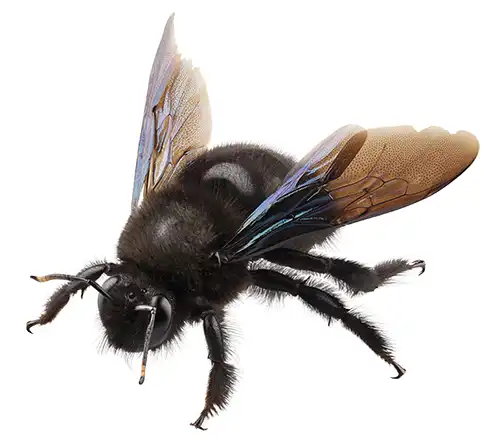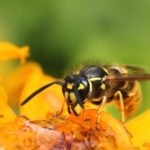
The Eastern Carpenter Bees over-winter as adults usually inside nest galleries. In the early spring, depending on weather, adult males and females emerge and mate. The male is very territorial when looking for a mate. Even though the male cannot sting, he will fly around in a threating manor at anyone who comes close to where a female is nesting. The female, on the other hand, can sting but rarely does unless picked-up and squeezed. The female is programed to mate and establish a nest. It is this behavior that she is preoccupied with. She does not have time to show aggression. The male plays no part in nest building or caring for the young. In fact, the male bee dies after mating. The fertilized female begins to establish a nest in suitable wood by initially chewing a round hole about the size of a dime perpendicular to the surface.
After a few inches, the female turns to the right and carves-out a channel about 8 to10 inches long. At the end of the tunnel, the female deposits a single egg. She provisions the cell with food consisting of chewed pollen and regurgitated liquid nectar. This material serves as food for the developing larva.
Once the cell has an egg and provisions, she constructs a partition and seals the cell. This process continues along the length of the tunnel until she finally seals the exterior opening and flies away looking for another nest site. The tunnel may consists of 8 – 12 brood cells. Eggs hatch within a few days, and the young larvae feed on the cache left by the mother. She may construct another gallery next to the one she just finished or may fly to a different location
Within a period of 5-7 weeks, depending on environmental conditions, the bee pupates and reaches adulthood. The new adult generation emerges in late summer to feed on nectar before settling in for the winter. The adult typically will occupy the nest burrow and will re-emerge in about 7 months. These new adult females begin excavating new tunnels or expanding tunnels from previous years.
The structural damage can be extensive if the bees are permitted to re-infest the same area year after year. The gallery openings allow water to enter and over time, this causes the wood to rot. In the northeast, there is one generation per year.
Mike Deutsch MS, BCE
Arrow Exterminating Co., Inc.
Lynbrook, NY






